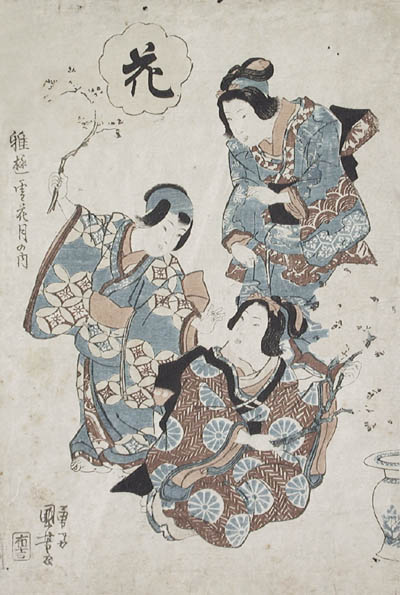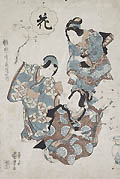| Title: |
Flowers (Children Playing) |
| Artist: |
Kuniyoshi, Ichiyasai (Japan, 1798 - 1861) |
| Date: |
c. 1840 |
| Medium: |
Original Japanese Woodcut |
| Publisher: |
Nunoyoshikichi (Nuno-kichi) |
| Sereies: |
Osana asobi sekkwagetsu no uchi (Snow, Moon and Flowers in Children's Games) |
| Note: |
"Kuniyoshi was a master of many facets but in the fields of legend and history he reigns supreme. His is the work that forms the yardstick against which all others are judged." *
|
| |
Mid nineteenth century Ukiyo-e art is best represented in its three most illustrious artists. The woodcuts of Hokusai and Hiroshige are permanently linked to the greatest images in Japanese landscape art. Yet the third master artist, Kuniyoshi, was equally adept at landscape, satire, figure studies and his famous legend and warrior prints. |
| |
A student of Toyokuni, Kuniyoshi in his art has always seemed more akin to Western thought and style than any other Golden Age Japanese master. He was, after all, the first to attempt consolidating Western temperament and themes into his art, usually with remarkable success. |
| |
Kuniyoshi's finest art was created from the 1830's and into the later years of the 1850's. After that date continuing ill health left its mark. Many of his most famous works draw from legend and history which gave him the imaginative vehicle to portray a vast spectrum of human emotions. His influence on the course of the Japanese woodcut was enormous and was directly passed on in the Meji era to his best student, Yoshitoshi. During the 1840's Ichiyasai Kuniyoshi made a number of studies of two of his most favoured subjects; children and cats. In both he wonderfully managed to capture the magic of these subjects. Kuniyoshi's, "Flowers" hails from the series: Moon and Flowers in Children's Games (Osana asobi sekkwagetsu no uchi) published by Ibaya Nunoyoshikichi (Nuno-kichi) between Between 1840 & 1850. is a finely created scene that only the genius of Kuniyoshi could delineate. Loosely translated, 'Osana asobi no uchi' means (children at play), and the large Japanese kanji character or symbol surrounded by a floral design means (Flowers or Blossoms).] |
| Reference: |
* Richard Illing, The Art of Japanese Prints, Gallery
Books, New York, 1983, pp. 120-122. |
| Raisonne: |
Basil William Robinson, Kuniyoshi, Victoria and Albert Museum, London, 1961, #81 |
| Size: |
14 1/2 X 9 7/8 (Sizes in inches are approximate,
height preceding width of plate-mark or image.) |
| |
Matted with 100% Archival Materials |
| Buy Now |
Price: $495.00 US |
| Condition: |
Printed upon mid-nineteenth century mulberry (rice) paper and with full margins as published for the series: Osana asobi sekkwagetsu no uchi (Snow, Moon and Flowers in Children's Games) between 1840 and 1850. (M. C. Dailey
lists Nonokichi as a publisher of Kuniyoshi between these dates.) Containing several very small silkworm holes in the upper and lower margins and some scuffing marks along the left margin, else a finely printed impression with full, unfaded colouration and in good condition throughout. Flowers represents a prime, original example of the art of Ichiyasai Kuniyoshi, one of the classic masters of the Japanese woodcut. |
| Important Information: |
The artist biographies, research and or information pertaining to all the original works of art posted on our pages has been written and designed by Greg & Connie Peters exclusively for our site, (www.artoftheprint.com). Please visit us regularly to view the latest artworks offered for sale. We will soon be posting an update of our most recent research and include the biographical and historical information pertaining to our next collection of original works of art created by artists throughout the centuries. We hope you found the information you were looking for and that it has been beneficial.
Our Gallery, (Art of the Print / www.artoftheprint.com) guarantees the authenticity of every work of art we sell 100%. Full documentation and certification is provided. We offer a wide selection of international fine art dating from the early Renaissance to the contemporary art period. |




![]()
![]() or
phone Greg & Connie (905) 957-6666
or
phone Greg & Connie (905) 957-6666